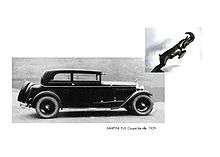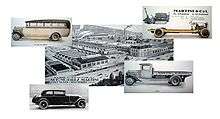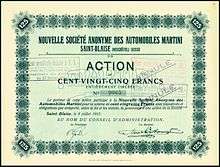Martini (automobile company)





Martini was a pioneer Swiss automobile manufacturer, in operation 1897 to 1934.
In 1897, Swiss businessman Adolf von Martini, son of Friedrich von Martini, the inventor of the Martini–Henry rifle, built an experimental rear-engined car. He followed this with V4 cars of 10 hp (7.5 kW) and 16 hp (2 kW) in 1902. Since Swiss cantons were unusually hostile to cars,[1] the company had to rely more than most on exports, and demand from abroad proved sufficient to justify building a factory in Saint-Blaise in 1904; von Martini relied on a licence from Rochet-Schneider of France, using an armored wood chassis and mechanically operated valves.
Promptly, his British sales agent, Captain H. H. P. Deasy, set off in a 16 hp on a 2,000-mile (3,200 km) trek through the Alps, which followed his earlier stunt of driving a cog-wheeled Martini up a mountain railway; his praise in both cases was effusive. By 1906, Deasy was sole salesman. That summer, with a 20 hp and a four-cylinder 40 hp available, Deasy made an ill-advised challenge to Rolls-Royce (which had a six-cylinder engine); Deasy, and (more importantly) Martini lost the 4,000-mile (6,400 km) "Battle of the Cylinders".
For 1907, there was also a chain driven 28 hp, and an entry in the Kaiserpreis rally, where the marque placed thirteenth and fifteenth. In 1908, showing the rapid pace of change, shaft drive was standard, in 12 hp, 16 hp and 20 hp models (all still four cylinder engines, however). That year's Coupe de Voiturettes saw 1086cc (66ci) inlet-over-exhaust SOHC-engined Martinis seventh, eighth, and tenth, enough for the team victory.
The racer was marketed as a 1909 road car, the 10/12, and new monobloc construction was standard across the line. Yet the engineers could not make up their minds; in 1910, they reverted to side valves, and in 1913, switched to sleeve valves for the 25/35, while there was a prototype sixteen-valve four, the marque's last racing attempt.
World War One and the subsequent recession crippled Swiss, and Martini, exports. In 1924, Martini was taken over by the Steiger brothers of Burgrieden,[2] the next year conceding the "Battle of the Cylinders" with a new six, licensed from Wanderer. This did not sell, and its replacement, the 4.4-liter NF, having four-wheel brakes (unusual for the period), was not enough to save the company. The NF soldiered on until 1934 before just fading away, Martini with it.
The Martini company also manufactured bookbinding machinery. They were purchased by Hans Müller and the company was renamed Müller Martini. The original factory is still in use today, and has a 1917 Martini car on display in the lobby of their Bookbinding Academy.
See also
Sources
- G.N. Georgano Cars: Early and Vintage, 1886-1930. London: Grange-Universal, 1985.
- Wise, David Burgess. "Martini: A New Star", in Northey, Tom, ed. The World of Automobiles. London: Orbis Publishing, 1974. Volume 11, pp. 1259–60.
References
- ↑ Wise, David Burgess. "Martini: A New Star", in Northey, Tom, ed. The World of Automobiles. (London: Orbis Publishing, 1974), Volume 11, pp.1259.)
- ↑ G.N. Georgano Cars: Early and Vintage, 1886-1930. (London: Grange-Universal, 1985)